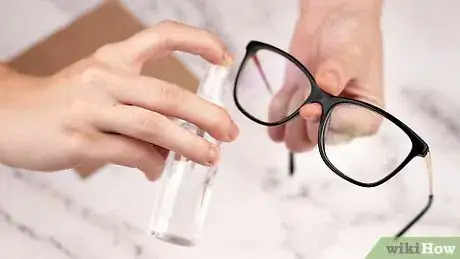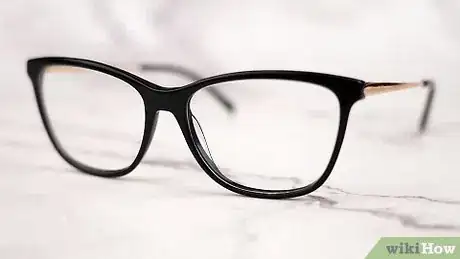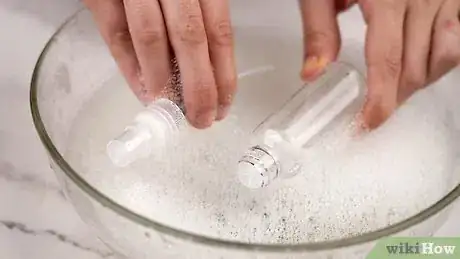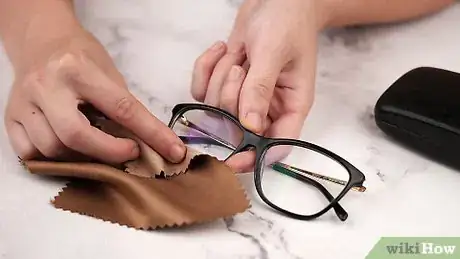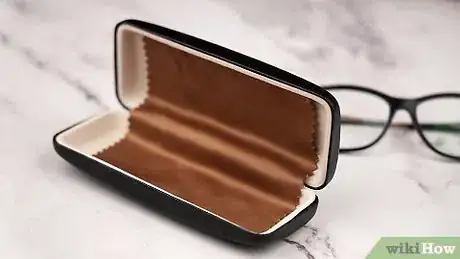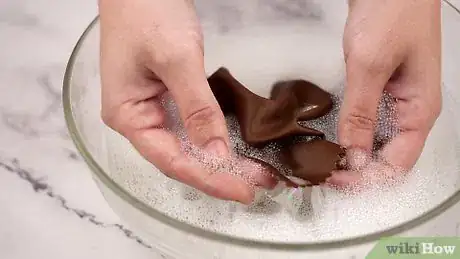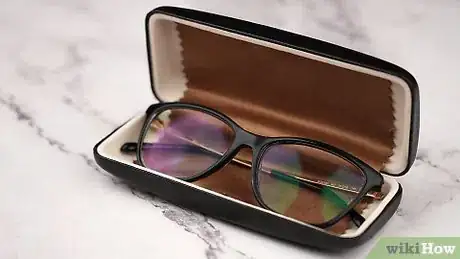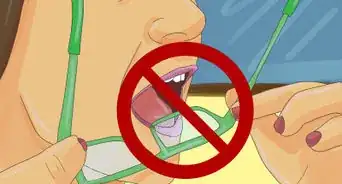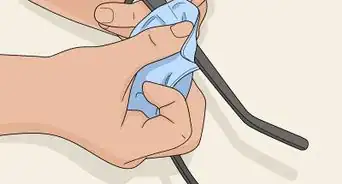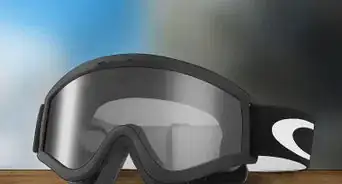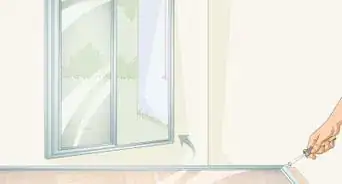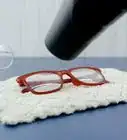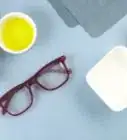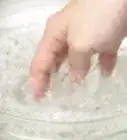This article was medically reviewed by Shaune Wallace, OD. Dr. Wallace is an Optometrist in Nevada with over 14 years of optometry experience. He received his OD from the Southern California College of Optometry in 2006 and is a member of the American Optometric Association.
There are 11 references cited in this article, which can be found at the bottom of the page.
This article has been viewed 258,775 times.
Glasses made cloudy by grime, damage, or dirtiness can reduce your vision to next-to-nothing. While there is little you can do to restore scratched lenses to a clearer state, there are tricks you can use to clean your cloudy glasses efficiently while preserving the lenses.[1] With the right supplies on hand and the knowledge of proper lens cleaning, soon you'll be seeing blue skies where once you only saw cloudy lenses.
Steps
Cleaning Cloudy Lenses
-
1Acquire a soft, clean cloth. In most cases, when you purchase your glasses from an optometrist, optical office, or eye boutique, you will also receive a microfiber cloth intended for cleaning your lenses. This cloth is ideal for cleaning smudges and cloudiness.
- If you've lost or misplaced your microfiber cloth, find a soft, clean substitute cloth. Cotton, so long as it's clean, should be suitable.[2] It is important to use fabric that is not treated with fabric softener as that can cause streaks on the lenses.[3]
- You should avoid using: coarse fabrics, like wool and certain synthetic fabrics, facial tissue, or toilet paper, as these will cause tiny scratches to form on your lenses over time.[4] [5]
-
2Make use of glasses cleaner. These solutions are specially formulated to cut through dirtiness without doing harm to your lenses or coatings that may be on your lenses. Spritz a moderate amount of the cleaner onto your lens and wipe it clean with your soft, clean cloth.
- Do not use your saliva to clean your lenses. Saliva won't clean especially well and is unhygienic.[6]
Advertisement -
3Clean with dish soap and warm water. If you don't happen to have glasses cleaner on hand, you can use a drop of dish soap and warm water to cut through grime and leave your lenses pristine.[7] Use your fingers and carefully spread the soap over the surface of your lenses. Rinse the lenses clean of soap with warm water, and you're ready to move on.
-
4Wipe your glasses with your soft cloth. After applying your cleaning solution, you can take your soft cloth and wipe your lenses dry in gentle, circular motions. You should try not to use scrubbing motions, which can lead to lens damage over time.[8]
-
5Inspect lenses for stubborn stains. Depending on just how dirty your glasses really are, you may need another application of cleaner before you lenses become fully clean. After using your cleaner or dish soap and hot water, wipe your lenses with your soft cloth.[9]
-
6Break up nose pad residue. Oil and dust can collect in the nook between your nose pads and lenses, creating a cloudy film in the area close to your nose. By using a soft bristle toothbrush, dish soap, and warm water, you can bust up this grimy buildup, though you should be careful not to scrub your lenses with the toothbrush.
- Fill a basin or container with warm water and soap.
- Dip your cleaning toothbrush into the solution and swish it around.
- Gently scrub at the metal arm that connects your nose pad to your glasses frames.
- Swish your toothbrush in your water/soap solution to remove dirt and gunk that accumulates on your brush.
- Rinse your glasses under warm water.
- Check for remaining grime and buildup and repeat scrubbing until fully clean.
Making Homemade Lens Cleaner
-
1Gather your supplies. Homemade lens cleaner won't damage the coating on your lenses like some other cleaning agents might, but you can count on it to cut through the clouds and smudges on your glasses. This is also a cheap alternative to ready-made eyeglass cleaner in the event that you ran out or weren't given any at your previous visit to the eye doctor. To make your own lens cleaner, you will need:
- Dish soap
- Isopropyl alcohol (or witch hazel)
- Measuring cup
- Microfiber cloth
- Small spray bottle
- Water[10]
-
2Prepare your supplies. You should clean your spray bottle and measuring cup before mixing your glass cleaning solution. This is because any dirt or dust left behind in these can contaminate your homemade lens cleaner. This is especially important if you are using a general purpose spray bottle that might have previously contained other household cleaners.
-
3Mix the liquids of your cleaner in equal parts. Now that your measuring cup and spray bottle are clean, you should measure your water and isopropyl alcohol in a 1-to-1 ratio and add each to your spray bottle.[11] [12] Swirl your bottle gently to mix the solution.
- For example, you may want to combine 1 ounce of water with 1 ounce of isopropyl alcohol in your spray bottle.
-
4Add your dish soap.[13] For this recipe, you will only need a very small amount of dish soap to give your lens cleaner some added smudge-fighting action. Put one drop of dish soap into your mixed solution of water and isopropyl alcohol. Cap your bottle and swirl its contents gently to infuse the solution with soap.
-
5Apply your cleaner and wipe away the clouds. Spray a moderate amount of your lens cleaner onto each lens. Now you can take your clean microfiber cloth and wipe away all the gunk that has accumulated on your glasses.[14]
- If you don't have a microfiber cloth intended for glasses, clean cotton should do the job.[15]
Preventing Cloudiness
-
1Use a clean, soft cloth always. The microfiber cloth that may have come with your glasses is ideal for cleaning your lenses, but even this can become dirty over time. Using a cloth that has dust on it will cause your lenses to develop small pits and scratches over time, creating cloudiness. To avoid this, only clean your glasses with a clean, soft cloth.[16]
-
2Protect your lens cloth from the elements. The more dust and grime that is on your lens cleaning cloth, the more damage you will do to your lenses over time. Every time you dry, wipe, or polish your lenses, you will be scraping these particles against your glasses.
- To keep your lens cloth cleanest, you may want to hold it in a glasses case that you carry with you throughout the day. You might also put this cloth in a plastic baggie or other container and tuck it away in a backpack or satchel.
-
3Wash your lens cleaning cloth. Depending on the cloth your are using, cleaning procedure can vary. A soft cotton piece of fabric can be washed normally, but you should follow the directions that came with your cloth. For cleaning a microfiber cloth, you should:
- Separate it with like-fabric items.
- Add a small amount of liquid detergent to your washing machine. Do not use fabric softener — this remains on the cloth and can leave streaks when using it on lenses.
- Set your washing machine to cold.
- Insert your microfiber cloth and like-cloth items into the wash.
- Air dry or use a dryer on a low/no-heat setting.[17]
-
4Clean your lenses regularly. Over the course of a day your glasses will normally collect dust, dirt, and oil from your face and hands. By cleaning your lenses regularly with glass cleaner or warm water and a drop of dish soap, you can cut down on the overall daily cloudiness you may experience.
-
5Keep your glasses in a case when you're not wearing them. This will keep dust from settling on the glasses and protect them from harm if they are knocked over. Instead of placing your glasses on your bedside table at night, for instance, place them in their case and then put that on your bedside table. This will also protect your glasses from getting broken or damaged if you knock them over when not in use.
Warnings
- Be gentle while cleaning, the last thing you want is a permanently scratched lens, broken nose pad, or bent frame.⧼thumbs_response⧽
Things You'll Need
Cleaning Cloudy Lenses
- Dish soap (optional)
- Glasses
- Glasses cleaning solution (optional)
- Microfiber cloth (or clean, soft cloth)
- Toothbrush (optional)
Making Homemade Lens Cleaner
- Dish soap
- Isopropyl alcohol (or witch hazel)
- Measuring cup
- Microfiber cloth (or clean, soft cloth)
- Small spray bottle
- Water
References
- ↑ http://www.allaboutvision.com/faq/eyeglasses.htm
- ↑ http://www.readers.com/resources/glasses/how-to-clean-and-maintain-glasses/
- ↑ http://www.allaboutvision.com/eyeglasses/how-to-clean-glasses.htm
- ↑ http://www.topcleaningsecrets.com/house/how-to-clean-eyeglasses.html
- ↑ http://www.readers.com/resources/glasses/how-to-clean-and-maintain-glasses/
- ↑ http://www.wsj.com/articles/SB10001424127887323375204578269942300847314
- ↑ http://www.wsj.com/articles/SB10001424127887323375204578269942300847314
- ↑ http://www.readers.com/resources/glasses/how-to-clean-and-maintain-glasses/
- ↑ http://www.topcleaningsecrets.com/house/how-to-clean-eyeglasses.html
- ↑ http://www.onegoodthingbyjillee.com/2013/03/make-your-own-eyeglass-cleaner.html
- ↑ http://www.livingonadime.com/homemade-eyeglass-cleaner-recipe/
- ↑ http://www.onegoodthingbyjillee.com/2013/03/make-your-own-eyeglass-cleaner.html
- ↑ http://lifehacker.com/5980802/the-correct-way-to-clean-eyeglasses
- ↑ http://www.howtocleanstuff.net/how-to-oily-remove-film-from-eye-glasses/
- ↑ http://lifehacker.com/5980802/the-correct-way-to-clean-eyeglasses
- ↑ http://www.wsj.com/articles/SB10001424127887323375204578269942300847314#articleTabs%3Darticle
- ↑ http://cleanmyspace.com/caring-for-your-microfiber-cloths/
About This Article
To clean cloudy glasses, make your own lens cleaner by mixing a drop of dish soap with equal parts warm water and isopropyl alcohol or witch hazel. Once prepared, spray the homemade solution on the lenses and wipe them down with a clean microfiber or cotton cloth. Additionally, make sure to keep your cleaning cloth free of dust and dirt or else you could accidentally scratch your glasses. When not in use, keep your microfiber cloth as well as your glasses in a protective case to keep excess dust away. To learn more from our Doctor of Optometry co-author, such as wash your cleaning rags, keep reading the article!

